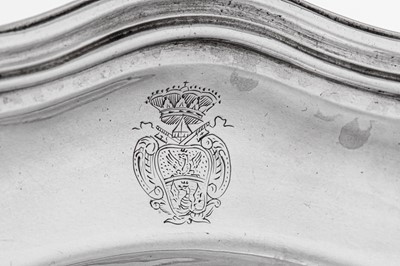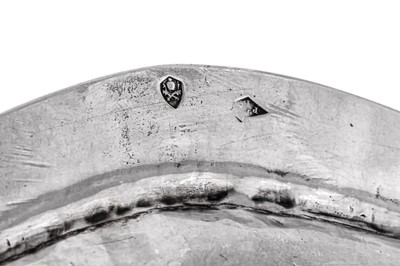3rd Mar, 2022 10:00
Silver & Objects of Vertu
Borghese service - An early 19th century Italian 889 standard silver second course dish, Rome circa 1825 by Pietro Paolo Spagna (active 1817-61)
Borghese service - An early 19th century Italian 889 standard silver second course dish, Rome circa 1825 by Pietro Paolo Spagna (active 1817-61)
Of shaped circular form with a moulded rim, the edge engraved with a coat of arms below a princely coronet and crossed keys. Marked to the reverse with second title mark (used 1817-1860), maker mark PPS1 in a lozenge (Donaver 2646).
Diameter – 31.5 cm / 12.45 inches
Weight – 913 grams / 29.39 ozt
The arms are for Borghese
for Camillo Filippo Ludovico Borghese, Prince of Sulmona VI, Duke and Prince of Guastalla (1775-1832) who married Pauline Bonaparte (1780 – 1825) Duchess of Guastalla, Imperial French Princess, sister of Napoleon I, Emperor of the French, in 1803 as her second husband.
The magnificent Borghese Service, comprising 500 silver-gilt objects primarily by Martin-Guillaume Biennais (1764-1843) and with over 1,000 other pieces by various makers, is traditionally thought to have been a gift from Napoleon to his second sister Pauline Bonaparte (1780-1825) on the occasion of her marriage to Prince Camillo Borghese (1775-1832) on 6 November, 1803. It is now believed that most of the service postdates 1805, when Napoleon was styled King of Italy. In addition many articles have Paris hallmarks for 1809-1819, and in the 1820's Florentine and Roman silversmiths contributed pieces to the service after original Biennais designs. These Roman pieces were probably ordered by Princess Pauline Borghese, who lived separately from her husband, in Rome from 1814-1828.
The marriage, which was Pauline Borghese's second, appears to have been an unhappy one, and they lived separately, with Pauline making her home in Paris while her husband accompanied the Emperor in the Austrian and Prussian campaigns and was made Governor of Piedmont, finally settling in Florence. Pauline was a renowned beauty, and was sculpted by Antonio Canova as Venus. Refused permission to join Napoleon in exile at St Helena in 1814, she moved to Rome where she lived at the Borghese Palace. She joined her husband in Florence shortly before her death. Both Pauline and Prince Borghese continued to commission additions to the Borghese Service. The coffee-pot is such an item, probably ordered by Pauline Borghese when living in Rome.
The service, which may have been split between Rome and Florence during their lifetimes, remained at the Borghese Palace until 1892, when it was sold as one lot at auction together with the rest of the contents of the Palace. A pair of wine-coolers and many other articles by Biennais from the Borghese Service are discussed, together with the history of the service, in A. Phillips and J. Sloane, Antiquity Revisited, English and French Silver-Gilt from the Collection of Audrey Love, London, 1997, pp. 98-112.
Pietro Spagna (1793-1861) came from a long line of Roman silversmiths and was the son of Giuseppi III. The firm started with the activity of Carl Spagna (1669-1680). He runs, together with his father, the workshop of Giuseppe Valadier from 1812 to 1817 at no. 90 Babuino, soon afterwards he purchased the shop and registered his first mark was entered in 1817.
A silver gilt coffee pot by this maker for this service was sold Christie’s London 12 June 2002, lot 10 (£47,800 incl. premium)
A wine cooler by this maker for this service was sold Sotheby’s 21 Oct 2010, lot 54 (£34,375 incl. premium)
Sold for £875
Includes Buyer's Premium
Do you have an item similar to the item above? If so please click the link below to submit a free online valuation request through our website.



